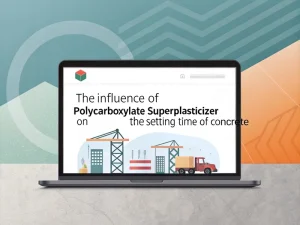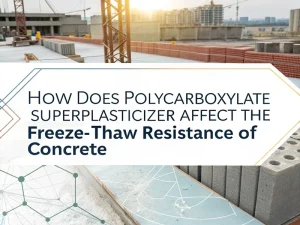
The Influence Of Polycarboxylate Superplasticizer On The Setting Time Of Concrete
Blog The influence of pol
Blog
Concrete is the most widely used building material worldwide, with an annual output exceeding 4 billion cubic meters. However, its production process comes with high environmental costs: cement manufacturing alone accounts for about 7% of global carbon dioxide (CO₂) emissions. As the construction industry accelerates the goal of “net zero emissions”, reducing the carbon footprint of concrete has become an urgent task.
Among the numerous innovative technologies driving this change, polycarboxylate superplasticizer (PCE) stands out due to its low cost and high impact. Unlike traditional water reducers, PCE’s unique molecular structure enables it to optimise concrete mix proportions, reduce cement usage, improve energy efficiency – while maintaining or even enhancing concrete performance.
The carbon footprint of concrete mainly comes from three stages:
Cement clinker production: the largest source of carbon emissions. The production of cement clinker (the core component of Portland cement) requires heating limestone (CaCO3) and clay in a rotary kiln to 1450 ℃ – this process not only releases CO₂ due to fuel combustion (such as coal and natural gas), but also generates chemical carbon emissions due to limestone decomposition (calcination reaction: CaCO3 → CaO+CO₂). For every ton of cement clinker produced, approximately 0.8 tons of CO₂ are emitted.
Aggregate mining and transportation: Mining aggregates such as sand and gravel, and transporting them to concrete mixing plants, consumes fossil fuels, resulting in indirect carbon emissions.
Concrete mixing and transportation: The process of mixing concrete and transporting it to the construction site by tanker trucks consumes a small amount of energy and generates emissions, but the proportion is relatively small.
Therefore, the core approach to reducing the carbon footprint of concrete is to reduce the amount of cement used—and this is precisely the key area where PCE plays a transformative role.
The most effective way for PCE to reduce its carbon footprint is to significantly reduce the water-cement ratio (W/C) without affecting processability.
The core function of PCE: PCE molecules effectively disperse cement particles through the combination of electrostatic repulsion and steric hindrance. This efficient dispersion releases water from cement aggregates (known as “trapped water”), converting it into “free water” to enhance fluidity.
Carbon reduction effect: PCE can usually achieve a water reduction rate of 25% to 40% or more. This enables concrete producers to achieve the required strength and durability with a lower water-cement ratio. To maintain the target strength (mainly determined by the water-cement ratio), manufacturers can now reduce the total amount of cement in the mixture while still meeting project specifications.
In concrete terms, every kilogram of cement saved is directly translated into a reduction in carbon emissions. Through PCE, the cement content can usually be reduced by 10-20%, thereby correspondingly reducing the carbon footprint of concrete.
SCM, Fly ash, slag, and silica fume are industrial by-products that can replace a portion of Portland cement in concrete mixtures. The carbon footprint of SCM is significantly lower than that of cement.
The role of PCE: A large amount of SCM usually increases water consumption and has a negative impact on the workability of newly poured concrete. The strong dispersing effect of PCE effectively counteracts this. It enables concrete producers to incorporate more SCM (e.g., 50% or more substitutes) while maintaining excellent workability, thereby achieving long-term strength and durability goals.
Carbon reduction effect: By achieving greater SCM substitution, PCE indirectly helps to avoid CO₂ emissions associated with producing alternative cement. This is a key strategy for producing “green concrete” or “low-carbon concrete”.
PCE improves the fluidity of concrete, which has energy-saving significance for the entire supply chain:
Reduce mixing energy: High fluidity concrete requires less energy for mixing and blending in mixing plants and trucks.
Easy to pour (pump): PCE reinforced concrete is easier to pump over long distances and at high altitudes, reducing the energy demand of concrete pumps.
Self-compacting concrete (SCC): PCE is crucial for the formation of SCC, which flows under its own weight and requires almost no vibration. This saves energy originally used for vibrators and reduces noise pollution on construction sites.
The durability contribution of PCE: By significantly reducing the W/C ratio, PCE creates a denser and less permeable concrete microstructure. This improved density enhances resistance to chloride intrusion, sulphate attack, and freeze-thaw cycles.
Energy saving effect: More durable structures require less maintenance, repair, or replacement. Reducing the use of cement means reducing CO₂ emissions.
Polycarboxylate superplasticizer (PCE) is a key technology for sustainable concrete production. By supporting high-dose, low-carbon SCMs, reducing the water-cement ratio and cement consumption, extending structural life, and optimising production efficiency, PCE achieves significant carbon reduction without sacrificing concrete performance or increasing overall costs.
For the construction industry, PCE is not an optional additive, but an essential tool to achieve the global net-zero emissions goal. When PCE is combined with scientific mix proportions (high SCMs content, optimised water-cement ratio) and best construction practices (avoiding on-site water addition, choosing low-carbon PCE), the carbon footprint of concrete can be reduced by 25 -40% – a key step towards a sustainable built environment.

The Influence Of Polycarboxylate Superplasticizer On The Setting Time Of Concrete
Blog The influence of pol

How Does Polycarboxylate Superplasticizer Affect The Freeze-thaw Resistance Of Concrete?
Blog How does polycarboxy